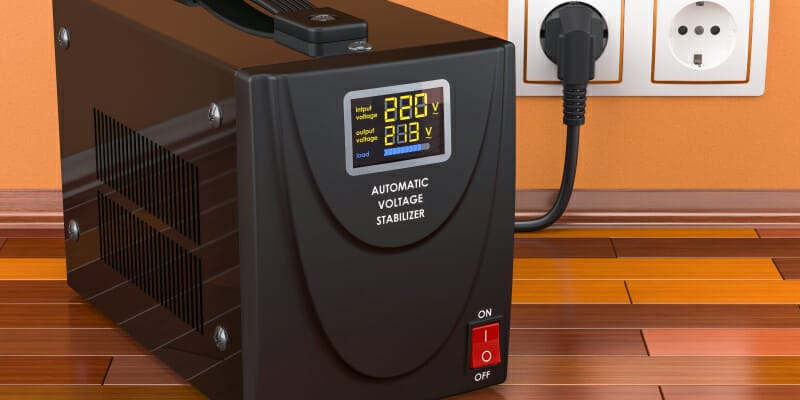- Home
- About us
- Products
- Dealer Enquiry
- Contact Us
- 044 -2486 1994
- +91 99623 98222
- sales@nantech.in
- REQUEST A QUOTE

Sensitive electronic equipment may break down with an unstable power supply. This will affect the business continuity and the equipment. 230 and 415 volts are the low-voltage electric power distribution standards for single-phase and three-phase. Most of the electrical equipment, especially single-phase ones, are made to work with voltages between 220 and 240V. Voltage variations usually range from 170 to 270 V. When there is a voltage swing; appliances may experience substantial negative impacts.
By regulating voltage fluctuations, servo voltage stabilizers are crucial to any electrical supply equipment. If you own sensitive electrical equipment at home, contact any renowned servo stabilizer manufacturer in Chennai for assistance. Servo stabilizers guard against damage and electrical risks. In this blog, learn more about servo voltage stabilizers' uses, applications, and how they may safeguard your appliances.
High voltage
When the voltage is high, electrical and electronic equipment's no-load current rapidly rises. High current damages electrical and electronic equipment's insulation, accelerates equipment failure, and increases equipment losses due to overheating.
Low voltage
Electric equipment's no-load current does not rise at low voltage, which does not impact the equipment's lifespan. However, if the voltage is too low (370V), the consumer must use a DG set, which is quite expensive.
Let us discuss how the failure of various electronic equipment happens with voltage fluctuation here.
A servo stabilizer is necessary to maintain consistent voltage and protect priceless gadgets to gain the desired performance. A voltage regulator employs a feedback control method to maintain a constant output voltage. It is employed in circumstances where the input voltage is unpredictable or vulnerable to fluctuations. Servo stabilizers are recommended in regions with a poorly controlled power grid or where frequent blackouts or brownouts affect the electrical supply.
Compared to traditional voltage regulators like transformers, servo voltage stabilizers are accurate. They respond to changes in input voltage more quickly and efficiently. These features make servo voltage stabilizers suitable for various applications to safeguard expensive and fragile electronic machinery.
Characteristics
Although servo stabilizers primarily regulate voltage, they also include a few additional characteristics to make them more user-friendly. Depending on the mounting method, servo stabilizers are often designed in various versions.
There are ones that are pole-mounted and wall-mounted, so they may be installed at positions that are high from the ground level. This is to prevent any power-related mishaps. As a result, they guarantee a safer environment in different areas.
To maintain security, they also include a time delay system. They may have more time to deal with the uneven voltage situations. They have a metre to view the voltage and other crucial power parameters. LED indicators are utilised for displaying a variety of things.
They enable overload prevention by quickly responding to an unexpected short-circuit, power outage, or integrated circuit burn. Therefore, servo stabilizers are user-friendly, environmentally friendly, trustworthy, and efficient.
Benefits
Applications & usage
To safeguard delicate electronic equipment, servo voltage stabilizers can be applied in a variety of contexts, including industrial, commercial, and residential ones.
Printing equipment
Even a slight voltage difference can ruin printed material. Therefore, servo stabilizers and equipment like flexographic machines, offset lithography, digital printing inkjet, and xerography are necessary for the printing sector.
CNC machines
CNC machines and other imported machinery require protection against voltage and power-related problems. This is because they possess intricate circuits that are precisely calibrated to specific output voltages, a guarantee that can only be achieved by utilising a high-quality servo stabilizer.
Medical equipment
Medical equipment is expensive. For these reasons, protecting the equipment from voltage issues such as spikes and fluctuation is essential. By limiting the incoming voltage, servo stabilizers are crucial equipment that prevents overloading. Servo stabilizers are of great use to medical equipment like CT scanners and MRI machines and prove to be a wise investment.
Textiles
Machines in the textile industry frequently use three-phase supply lines, and these connections often experience voltage swings. A servo stabilizer is used to stop such voltage fluctuations so that the machines run without technical problems like overloading. Eventually, it helps in preventing any harm to the electrical equipment.
Plants/factories
Modern industrialists managing factories understand the value of servo voltage stabilizers and voltage controllers. They never think twice and invest in servo voltage stabilizers during the early stages while planning the factory.
Servo voltage stabilizers are widely used in various industries, including engineering, cold storage, air conditioning, cement, flour, oil, paper, rubber, tea estates, food processing, footwear and leather, distilleries and beverages. They are also used in clubs, multi-storey buildings, call centres and export houses.
Final words
When voltage stabilizers are implemented, you won't need to make any expensive replacements or repairs. Servo stabilizer suppliers will ensure that voltage fluctuations are taken care of in any circumstance. Contact Nantech Power Systems, one of the best UPS manufacturers in Chennai, and we'll help you determine the best course of action for your company's requirements.
Servo Voltage Stabilizers: - Air-Cooled vs Oil-Cooled
DETAILED GUIDE ON SERVO STABILIZERS- TO SERVE AND STABILIZE
4 Incredible Benefits Of A Servo Voltage Stabilizer!
What Are The Different Types Of Servo Voltage Stabilizers?
Replace a UPS Battery or Buy a New UPS System?
A Closer Look at Solar Inverter vs Normal Inverter